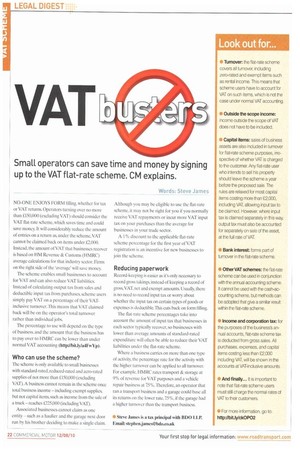VAT
Page 22

If you've noticed an error in this article please click here to report it so we can fix it.
Small operators can save time and money by signing up to the VAT flat-rate scheme. CM explains.
Words: Steve James
NO-ONE ENJOYS FORM filling, whether for tax or VAT returns. Operators turning over no more than £150,000 (excluding VAT) should consider the VAf flat-rate scheme, which saves time and could save money. It will considerably reduce the amount of entries on a return as, under the scheme, VAT cannot be claimed back on items under £21)00. Instead, the amount of VAT that businesses recover is based on HM Revenue & Customs (HMRC) average calculations for that industry sector. Firms on the right side of the 'average' will save money.
The scheme enables small businesses to account for VAT and can also reduce VAT liabilities. Instead of calculating output tax from sales and deductible input tax from purchases. scheme users simply pay VAT on a percentage of their VATinclusive turnover. This means that VAT claimed back will he on the Operator's total turnover rather than individual jobs.
The percentage to use will depend on the type of business, and the amount that the business has to pay over to HMRC can be lower than under normal VAT accou Filing (http://bit.ly/a4FwYp).
Who can use the scheme?
The scheme is only available to small businesses with standard-rated, reduced-rated and zero-rated supplies of not more than i150,000 (excluding VAT). A business cannot remain in the scheme once total business income — including exempt supplies, hut not capital items. such as income from the sale of a truck — reaches £225,000 (including VAT).
Associated businesses cannot claim as one entity — such as a haulier and the garage next door run by his brother deciding to make a single claim. Although you may be eligible to use the flat-rate scheme, it may not be right for you if you normally receive VAT repayments or incur more VAT input tax on your purchases than the average for businesses in your trade sector.
A 1% discount to the applicable flat-rate scheme percentage for the first year of VAT registration is an incentive for new businesses to join the scheme.
Reducing paperwork
Record-keeping is easier as it's only necessary to record gross takings. instead of keeping a record of gross, VAT net and exempt amounts. Usually, there is no need to record input tax or worry about whether the input tax on certain types of goods or expenses is deductible, This cuts back on form filling.
The flat-rate scheme percentages take into account the amount of input tax that businesses in each sector typically recover, so businesses with lower than average amounts of standard-rated expenditure will often be able to reduce their VAT liabilities under the flat-rate scheme.
Where a business carries on more than one type of activity. the percentage rate for the activity with the higher turnover can be applied to all turnover. For example, HMRC rates transport & storage at 9% of revenue for VAT purposes and a vehicle repair business at 75%.Therefore, an operator that ran a transport business and a garage could base all its returns on the lower rate. 7.5%, if the garage had a higher turnover than the transport business.








































































































































